Richmond, Indiana
| City of Richmond, Indiana | |
|---|---|
| — City — | |
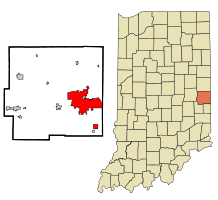 |
|
| Coordinates: | |
| Country | United States |
| State | Indiana |
| County | Wayne |
| Township | Boston, Center, Wayne |
| Government | |
| - Mayor | Sarah L. "Sally" Hutton (D) |
| Area | |
| - Total | 23.3 sq mi (60.3 km2) |
| - Land | 23.2 sq mi (60.1 km2) |
| - Water | 0.1 sq mi (0.2 km2) |
| Elevation | 981 ft (299 m) |
| Population (2000) | |
| - Total | 39,124 |
| - Density | 1,685.6/sq mi (650.8/km2) |
| Time zone | EST (UTC-5) |
| - Summer (DST) | EDT (UTC-4) |
| ZIP codes | 47374-47375 |
| Area code(s) | 765 |
| FIPS code | 18-64260[1] |
| GNIS feature ID | 0441976[2] |
| Website | http://www.richmondindiana.gov |
Richmond (pronounced /ˈrɪtʃmənd/) is a city largely within Wayne Township, Wayne County, in east central Indiana, which borders Ohio. The city also includes the Richmond Municipal Airport, which is in Boston Township and separated from the rest of the city. It is sometimes called the "cradle of recorded jazz" because some early jazz records were made here at the studio of Gennett Records, a division of the Starr Piano Company.[3]
Richmond is the county seat of Wayne County. The city's 2000 population was 39,124. In the 1990s, Richmond's population declined by 1.6 percent.[4] Like many cities that formerly depended on manufacturing, Richmond is having to create a new economy. Its rich architectural heritage and Main Street attest to a strong base. The city has twice received the All-America City Award, most recently in a youth-initiated 2009 effort.
Contents |
Geography
Richmond is located at .[5]
According to the United States Census Bureau, the city has a total area of 23.3 square miles (60.3 km²), of which, 23.2 square miles (60.1 km²) of it is land and 0.1 square miles (0.2 km²) of it (0.26%) is water.
Demographics
As of the census[1] of 2000, there were 39,124 people, 16,287 households, and 9,918 families residing in the city. The population density was 1,685.3 people per square mile (650.8/km²). There were 17,647 housing units at an average density of 760.2/sq mi (293.6/km²). The racial makeup of the city was 86.78% White, 8.87% African American, 0.27% Native American, 0.80% Asian, 0.06% Pacific Islander, 1.09% from other races, and 2.14% from two or more races. Hispanic or Latino of any race were 2.03% of the population.
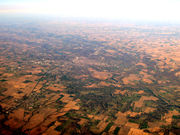
| Historical populations | |||
|---|---|---|---|
| Census | Pop. | %± | |
| 1840 | 2,070 |
|
|
| 1850 | 1,443 | −30.3% | |
| 1860 | 6,608 | 357.9% | |
| 1870 | 9,445 | 42.9% | |
| 1880 | 12,742 | 34.9% | |
| 1890 | 16,608 | 30.3% | |
| 1900 | 18,226 | 9.7% | |
| 1910 | 22,824 | 25.2% | |
| 1920 | 26,765 | 17.3% | |
| 1930 | 32,493 | 21.4% | |
| 1940 | 35,147 | 8.2% | |
| 1950 | 39,539 | 12.5% | |
| 1960 | 44,149 | 11.7% | |
| 1970 | 43,999 | −0.3% | |
| 1980 | 41,349 | −6.0% | |
| 1990 | 38,705 | −6.4% | |
| 2000 | 39,124 | 1.1% | |
| Source: US Census Bureau | |||
There were 16,287 households out of which 27.8% had children under the age of 18 living with them, 43.1% were married couples living together, 13.9% had a female householder with no husband present, and 39.1% were non-families. 33.0% of all households were made up of individuals and 13.7% had someone living alone who was 65 years of age or older. The average household size was 2.29 and the average family size was 2.89.
In the city the population was spread out with 23.4% under the age of 18, 11.0% from 18 to 24, 27.5% from 25 to 44, 21.6% from 45 to 64, and 16.4% who were 65 years of age or older. The median age was 36 years. For every 100 females there were 88.7 males. For every 100 females age 18 and over, there were 84.2 males.
The median income for a household in the city was $30,210, and the median income for a family was $38,346. Males had a median income of $30,849 versus $21,164 for females. The per capita income for the city was $17,096. About 12.1% of families and 15.7% of the population were below the poverty line, including 22.8% of those under age 18 and 10.8% of those age 65 or over.
According to an estimate released in 2009 by the United States Census Bureau, Wayne County, of which Richmond is the county seat, had a relatively high population of divorced residents: 19.2 percent. Among 54,810 native-born residents 19.4 percent were divorced, and among 550 foreign-born residents none were divorced. Among Whites, 18.7 percent were divorced, while 11.6 percent of Blacks or African Americans were divorced. The age category with the highest percentage of divorced person was 45-54. (males: 35 percent; females 33.5 percent). Among males and females aged 15–19, the percent divorced was zero.[6]
History
For thousands of years inhabited by indigenous peoples, this area in historic times was inhabited by Native Americans of a variety of nations.
In 1806 the first European Americans, Quaker families from North Carolina, settled along the East Fork of the Whitewater River. This was part of a general westward migration in the early decades after the American Revolution. John Smith and David Hoover were among the earliest settlers. Richmond is still home to several Quaker institutions, including Friends United Meeting, Earlham College and the Earlham School of Religion.
The city was connected to the National Road, the first road built by the federal government and a major route west for pioneers of the 19th century.[7] It became part of the system of National Auto Trails. The highway is now known as ![]() U.S. Highway 40. One of the extant Madonna of the Trail monuments was dedicated at Richmond on October 28, 1928[8] The monument sits in a corner of Glen Miller Park adjacent to US 40.
U.S. Highway 40. One of the extant Madonna of the Trail monuments was dedicated at Richmond on October 28, 1928[8] The monument sits in a corner of Glen Miller Park adjacent to US 40.
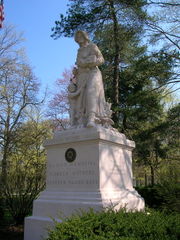
Richmond is believed to have been the smallest community in the United States to have supported a professional opera company and symphony orchestra. The Whitewater Opera has since closed but the Richmond Symphony Orchestra has continued as a source of community pride. In 1899 Will Earhart formed the first complete high school orchestra in the nation. A later high school orchestra director, Joseph E. Maddy, went on to found what is now known as the Interlochen Center for the Arts in Michigan.
A significant group of artists in the area in the late 19th and early 20th centuries came to be known as the Richmond Group. They includes John Elwood Bundy, Charles Conner, George Herbert Baker, Maude Kaufman Eggemeyer and John Albert Seaford, among others. The Richmond Art Museum has an outstanding collection of regional and American art.[9] Many consider the most significant painting in the collection to be a self portrait of Indiana-born William Merritt Chase.[10]
Richmond's cultural resources include two of Indiana's three Egyptian mummies. One is held by the Wayne County Historical Museum and the second by Earlham College's Joseph Moore Museum. [11] [12]
The arts were supported by a strong economy increasingly based on manufacturing. Richmond was once known as "the lawnmower capital" because it was a center for manufacturing of lawn mowers from the late 19th century through the mid-20th century. Manufacturers included Davis, Motomower, Dille-McGuire and F&N. The farm machinery builder Gaar-Scott was based in Richmond.
After starting out in nearby Union City, Wayne Agricultural Works moved to Richmond. Wayne was a manufacturer of horse-drawn vehicles, including "kid hacks", a precursor of the motorized school bus. From the early 1930s through the 1940s, several automobile designers and manufacturers were located in Richmond. Among the automobiles locally manufactured was the "Richmond", built by the Wayne Works; the "Rodefeld"; the "Davis"; the "Pilot"; the Westcott and the Crosley.
In the 1950s, Wayne Works changed its name to Wayne Corporation, by then a well-known bus and school-bus manufacturer. In 1967 it relocated to a site adjacent to Interstate 70. The company was a leader in school-bus safety innovations, but it closed in 1992 during a period of school-bus manufacturing industry consolidations.
Richmond was known as the "Rose City" because of the many varieties once grown there by Hill's Roses. The company had several sprawling complexes of greenhouses, with a total of about 34 acres (140,000 m2) under glass. The annual Richmond Rose Festival honored the rose industry and was a popular summer attraction.
KKK
In the 1920s during the national revival of the Ku Klux Klan (KKK), Indiana had the strongest organization in the country, led by Grand Dragons D. C. Stephenson and Walter F. Bossert. Some men initially joined the KKK as a fraternal organization, as that was how it was marketed. In addition, they were banding together in reaction to the influx of newcomers arriving for industrial jobs: especially Catholic immigrants from eastern and southern Europe, and rural black migrants from the South. The KKK had members in the state legislature who exerted control and an ally in Governor Ed Jackson.[13] At its height, national membership during the second Klan movement reached 1.5 million, with 300,000 from Indiana.[14]
Records show that Richmond (home to Whitewater Klan #60) and Wayne County were Klan strongholds, with up to 45 percent of the county's white males having been Klan members. Forty percent of Richmond's Kiwanis club members, thirty percent of its doctors, and 27 percent of its lawyers were Klan members, but none of the city's bank executives or most powerful business leaders were members.[14][15] In 1923 a reported 30,000 people watched a Klan parade through Richmond streets.[16] Richmondite Robert Lyons was national chief of staff for the Klan.[17]
Gennett Records was making some of the first recordings of important black jazz artists, helping Richmond gain the nickname "cradle of recorded jazz."[18] Given the social demographics, it also produced private-label contract recordings for the KKK.[19] Official racial segregation existed in Richmond until 1965, when the city ended its policy of restricting black firefighters to one station and limiting promotion opportunities of firefighters and police officers. That same year the state of Indiana repealed its standing (but seldom enforced) anti-miscegenation law.
20th century challenges
On April 6, 1968, a natural gas explosion and fire destroyed or damaged several downtown blocks and killed 41 people; more than 150 were injured.[20] The book Death in a Sunny Street is about the event.
In the rebuilding effort, the city closed the main street through downtown to traffic and built the Downtown Promenade in 1972 (expanded in 1978). When studies showed that car traffic helped businesses, the city had the five-block pedestrian mall broken up. It reopened the street to traffic in 1997 as part of an urban revitalization effort.
A Powerball lottery ticket sold in Richmond won approximately $314 million (annuity value) in the August 25, 2007 drawing. This exceeded a previous high prize in 1998, when a group of 13 machine-shop workers from Ohio won Powerball on a ticket also purchased in Richmond. It won $295.7 million (annuity). The two tickets were sold at two different Speedway convenience stores about three miles (5 km) apart; both sets of winners chose the cash option.
Architecture
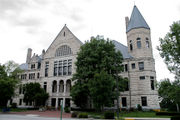
Richmond is noted for its rich stock of historic architecture. In 2003, a book entitled Richmond Indiana: Its Physical Development and Aesthetic Heritage to 1920 by Cornell University architectural historians, Michael and Mary Raddant Tomlan, was published by the Indiana Historical Society. Particularly notable buildings are the 1902 Pennsylvania Railroad Station designed by Daniel Burnham of Chicago and the 1893 Wayne County Court House designed by James W. McLaughlin of Cincinnati. Local architects of note include John A. Hasecoster, William S. Kaufman and Stephen O. Yates.
The significance of the architecture has been recognized. Five large districts, such as the Depot District, and several individual buildings are listed in the National Register of Historic Places, the Historic American Buildings Survey and the Historic American Engineering Record.
Educational institutions
- Richmond has four colleges: Earlham College, Indiana University East, Ivy Tech Community College of Indiana and the Purdue University School of Technology.
- Richmond is home to two seminaries: Earlham School of Religion (Quaker) and Bethany Theological Seminary (Church of the Brethren)
- Richmond High School includes the Richmond Art Museum and Civic Hall Performing Arts Center and the Tiernan Center, the 5th-largest high school gym in the United States.
- Seton Catholic High School (founded 2002), a junior and senior high school, is the area's only religious high school. It is based in the former home of St. Andrew High School (1899–1936) and, more recently, St. Andrew Elementary School, adjacent to St. Andrew Church of the Richmond Catholic Community.
Religious groups
- Richmond is the headquarters of the Friends United Meeting of the Religious Society of Friends (Quakers).
Transportation
Richmond is served by Interstate 70 at exits 149, 151, 153, and 156.
Media
The daily newspaper is the Gannett-owned Palladium-Item.
Full-power radio stations include WKBV, WFMG, WQLK, WHON, WKRT, and Earlham College's student-run public radio station WECI. Richmond is also served by several translator stations repeated from WCDR on 95.3 and 90.7 and WJYW which is repeated on 94.5 and 97.7. Area NPR radio stations include WBSH in Hagerstown and WMUB in Oxford, OH.
Richmond is considered to be within the Dayton, Ohio television market and has one full-power television station, WKOI, which is affiliated with TBN. The city also has one county-wide PEG access cable television station, Whitewater Community Television.[21]
Points of interest
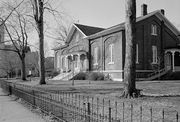
- Hayes Arboretum
- Wayne County Historical Museum
- Richmond Art Museum
- Indiana Football Hall of Fame
- Abram Gaar House and Farm (house museum)
- Joseph Moore Museum at Earlham College
- Glen Miller Park and Madonna of the Trail statue
- Old Richmond Historic District
- Starr Historic District
- Richmond Railroad Station Historic District
- Reeveston Place Historic District
- East Main Street-Glen Miller Park Historic District
- Reid Memorial Presbyterian Church [1] (Louis Comfort Tiffany-designed interior and windows, Hook and Hastings organ)
- Bethel AME Church (oldest AME church in Indiana: founded 1868)
- Old National Road Welcome Center (convention and tourism bureau)
- Whitewater Gorge Park and Gennett Walk of Fame
- Cardinal Greenway hiking trail
- Morrisson Reeves Library and historical archive
- Marceline Jones gravesite, Earlham Cemetery (Jim Jones's wife, who died in the Peoples Temple mass suicide)
- Richmond Civic Theatre (plays, classic movies, and children's theater)
- Madonna of the Trail statue at Glen Miller Park
- Gennett Records Walk of Fame
Notable Richmondites
|
|
Sister cities
 Serpukhov, Russia
Serpukhov, Russia Daito-Cho, Shimane Prefecture, Japan
Daito-Cho, Shimane Prefecture, Japan
Notes
- ↑ 1.0 1.1 "American FactFinder". United States Census Bureau. http://factfinder.census.gov. Retrieved 2008-01-31.
- ↑ "US Board on Geographic Names". United States Geological Survey. 2007-10-25. http://geonames.usgs.gov. Retrieved 2008-01-31.
- ↑ Starr Gennett Foundation, http://starrgennett.org/, URL accessed May 29, 2006.
- ↑ Richmond, Indiana (IN) Detailed Profile - relocation, real estate, travel, jobs, hospitals, schools, crime, news, sex offenders
- ↑ "US Gazetteer files: 2000 and 1990". United States Census Bureau. 2005-05-03. http://www.census.gov/geo/www/gazetteer/gazette.html. Retrieved 2008-01-31.
- ↑ Wayne County, Indiana S1201. Marital Status; United States Census Bureau http://factfinder.census.gov/servlet/STTable?_bm=y&-state=st&-context=st&-qr_name=ACS_2008_1YR_G00_S1201&-ds_name=ACS_2008_1YR_G00_&-tree_id=308&-_caller=geoselect&-geo_id=05000US18177&-format=&-_lang=en, URL accessed September 23, 2009.
- ↑ "Road through the Wilderness: The Making of the National Road", URL accessed May 30, 2006.
- ↑ "Madonna of the Trail", Wayne County, URL accessed May 30, 2006.
- ↑ Richmond Art Museum, http://www.richmondartmuseum.org/, URL accessed May 30, 2006.
- ↑ William Merritt Chase, Self-portrait: The Artist in his Studio, 1916, URL accessed May 30, 2006
- ↑ Wayne County Historical Museum, http://waynecountyhistoricalmuseum.com/, URL accessed December 13, 2008.
- ↑ Joseph Moore Museum, http://www.waynet.org/nonprofit/jos_moore.htm, URL accessed December 13, 2008.
- ↑ "Ku Klux Klan Resources", Indiana Division, Indiana State Library, URL accessed May 30, 2006
- ↑ 14.0 14.1 "Ku Klux Klan", Wayne County, Indiana Records, 1916–1933, Indiana History, URL accessed May 29, 2006
- ↑ Leonard J. Moore, Citizen Klansmen: The Ku Klux Klan in Indiana, 1921-1928, North Carolina Press, 1997.
- ↑ "Spectacular array presented by Klan in mamoth [sic] parade", Richmond Evening Item, Oct. 6, 192, pp. 1, 2
- ↑ "Klan issue in Democrat race for president", Richmond Evening Item, May 14, 1924, p. 1.
- ↑ "How the Early Jazz Captured by Gennett Influenced the Shape of Things to Come", http://starrgennett.org/stories/articles/way_station.htm, URL accessed May 29, 2006.
- ↑ Gennett Numerical Series, http://www.vjm.biz/new_page_6.htm, URL accesses May 29, 1006,
- ↑ Death in a Sunny Street : The Civil Defense Story of the Richmond, Indiana Disaster, April 6, 1968, URL accessed May 29, 2006.
- ↑ Whitewater Community Television home page.
- ↑ Polly Bergen, http://www.meredy.com/pollybergen/, URL accessed May 30, 2006.
- ↑ Clark Bradley, http://sports.espn.go.com/prorodeo/features/bio?page=g_bio_PRCA_Bradley_CR, URL accessed October 28, 2006.
- ↑ Really Good Music: Al Cobine, http://www.reallygoodmusic.com/rgm.jsp?page=composers2&compid=123140, URL accessed September 9, 2006.
- ↑ Space Age Pop Music: George Duning, http://www.spaceagepop.com/duning.htm, URL accessed September 9, 2006.
- ↑ Weeb Ewbank, http://www.profootballhof.com/hof/member.jsp?player_id=65, URL accessed May 30, 2006.
- ↑ FindAGrave: Norman Foster, http://www.findagrave.com/cgi-bin/fg.cgi?page=gr&GRid=11777752&pt=%3Cb%3ENorman%3C/b%3E%20Foster, URL accessed September 9, 2006.
- ↑ FindAGrave: Harry Frankel, http://www.findagrave.com/cgi-bin/fg.cgi?page=gr&GRid=10193921, URL accessed September 9, 2006.
- ↑ Jazz at Newport 2006, http://www.jazzatnewport.org/home.cfm?dir_cat=47265, URL accessed September 9, 2006.
- ↑ Mendel Medal recipient: Charles A. Hufnagel, http://astro4.ast.vill.edu/mendel/hufnagel.htm, URL accessed September 9, 2006.
- ↑ Harold Jones' web site, http://www.haroldjonesbigband.com/, URL accessed May 30, 2006.
- ↑ Harry Keenan, http://www.imdb.com/name/nm0444645/, URL accessed September 9, 2006.
- ↑ Esther A. Kellner (1908-1998), http://www.mrlinfo.org/history/biography/kellner.htm, URL accessed May 29, 2006.
- ↑ Wheaton College Special Collections, http://www.wheaton.edu/learnres/ARCSC/collects/sc38/bio.htm, 2006.
- ↑ Naples Illustrated, Past Lives, http://www.naplesillustrated.com/index.cfm?fuseaction=display_article&whicharticle=112, URL accessed September 9, 2006.
- ↑ Kenneth MacDonald, http://www.surfnetinc.com/chuck/villan27.htm, URL accessed September 9, 2006.
- ↑ Oliver Hazard Perry Throck Morton, http://www.civilwarhome.com/mortonbio.htm, URL accessed May 30, 2006.
- ↑ Official Ned Rorem Website, http://www.nedrorem.com/, URL accessed May 30, 2006.
- ↑ Uncrowned Queens: L. Lena Sawyer, http://www.buffalo.edu/uncrownedqueens/files_2004/sawner_lena.htm, URL accessed May 29, 3006.
- ↑ American Sportscasters Hall of Fame Inductee, http://www.americansportscasters.com/schenkel.html, URL accessed September 9, 2006.
- ↑ Wendell M. Stanley, http://nobelprize.org/chemistry/laureates/1946/stanley-bio.html, URL accessed May 30, 2006.
- ↑ D. Elton Trueblood, http://www.waynet.org/people/biography/trueblood.htm, URL accessed May 30, 2006.
- ↑ Carol Lou Trio, http://carolloutrio.pbwiki.com/, URL accessed January 20, 2008.
- ↑ "The Wright Brother", URL accessed May 30, 2006
External links
|
|||||||||||||||||
|
|||||
|
||||||||||||||||||||